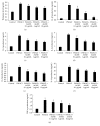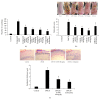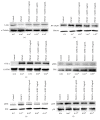Effects of Angelica gigas Nakai as an Anti-Inflammatory Agent in In Vitro and In Vivo Atopic Dermatitis Models
- PMID: 29713361
- PMCID: PMC5866876
- DOI: 10.1155/2018/2450712
Effects of Angelica gigas Nakai as an Anti-Inflammatory Agent in In Vitro and In Vivo Atopic Dermatitis Models
Abstract
We investigated the cellular and molecular mechanisms mediating the effects of Angelica gigas Nakai extract (AGNE) through the mitogen-activated protein kinases (MAPKs)/NF-κB pathway using in vitro and in vivo atopic dermatitis (AD) models. We examined the effects of AGNE on the expression of proinflammatory cytokines and chemokines in human mast cell line-1 (HMC-1) cells. Compound 48/80-induced pruritus and 2,4-dinitrochlorobenzene- (DNCB-) induced AD-like skin lesion mouse models were also used to investigate the antiallergic effects of AGNE. AGNE reduced histamine secretion, production of proinflammatory cytokines including interleukin- (IL-) 1β, IL-4, IL-6, IL-8, and IL-10, and expression of cyclooxygenase- (COX-) 2 in HMC-1 cells. Scratching behavior and DNCB-induced AD-like skin lesions were also attenuated by AGNE administration through the reduction of serum IgE, histamine, tumor necrosis factor-α (TNF-α), IL-6 levels, and COX-2 expression in skin tissue from mouse models. Furthermore, these inhibitory effects were mediated by the blockade of the MAPKs and NF-κB pathway. The findings of this study proved that AGNE improves the scratching behavior and atopy symptoms and reduces the activity of various atopy-related mediators in HMC-1 cells and mice model. These results suggest the AGNE has a therapeutic potential in anti-AD.
Figures





Similar articles
-
Korean Red Ginseng improves atopic dermatitis-like skin lesions by suppressing expression of proinflammatory cytokines and chemokines in vivo and in vitro.J Ginseng Res. 2017 Apr;41(2):134-143. doi: 10.1016/j.jgr.2016.02.003. Epub 2016 Feb 19. J Ginseng Res. 2017. PMID: 28413317 Free PMC article.
-
Effects and mechanism of action of Huang-Lian-Jie-Du-Tang in atopic dermatitis-like skin dysfunction in vivo and in vitro.J Ethnopharmacol. 2019 Aug 10;240:111937. doi: 10.1016/j.jep.2019.111937. Epub 2019 May 7. J Ethnopharmacol. 2019. PMID: 31075381
-
(R)-(+)-pulegone suppresses allergic and inflammation responses on 2,4-dinitrochlorobenzene-induced atopic dermatitis in mice model.J Dermatol Sci. 2018 Sep;91(3):292-300. doi: 10.1016/j.jdermsci.2018.06.002. Epub 2018 Jun 12. J Dermatol Sci. 2018. PMID: 29933898
-
Cynanchum atratum inhibits the development of atopic dermatitis in 2,4-dinitrochlorobenzene-induced mice.Biomed Pharmacother. 2017 Jun;90:321-327. doi: 10.1016/j.biopha.2017.03.065. Epub 2017 Mar 30. Biomed Pharmacother. 2017. PMID: 28365521
-
Topical Application of Angelica sinensis Improves Pruritus and Skin Inflammation in Mice with Atopic Dermatitis-Like Symptoms.J Med Food. 2016 Jan;19(1):98-105. doi: 10.1089/jmf.2015.3489. Epub 2015 Aug 25. J Med Food. 2016. PMID: 26305727
Cited by
-
Therapeutic Effects of Decursin and Angelica gigas Nakai Root Extract in Gerbil Brain after Transient Ischemia via Protecting BBB Leakage and Astrocyte Endfeet Damage.Molecules. 2021 Apr 9;26(8):2161. doi: 10.3390/molecules26082161. Molecules. 2021. PMID: 33918660 Free PMC article.
-
Effect and Mechanism of Herbal Medicines on Cisplatin-Induced Anorexia.Pharmaceuticals (Basel). 2022 Feb 9;15(2):208. doi: 10.3390/ph15020208. Pharmaceuticals (Basel). 2022. PMID: 35215322 Free PMC article. Review.
-
Chemical Composition of a Novel Distillate from Fermented Mixture of Nine Anti-Inflammatory Herbs and Its UVB-Protective Efficacy in Mouse Dorsal Skin via Attenuating Collagen Disruption and Inflammation.Molecules. 2020 Dec 29;26(1):124. doi: 10.3390/molecules26010124. Molecules. 2020. PMID: 33383913 Free PMC article.
-
Network Pharmacology-Based Investigation of the System-Level Molecular Mechanisms of the Hematopoietic Activity of Samul-Tang, a Traditional Korean Herbal Formula.Evid Based Complement Alternat Med. 2020 Feb 13;2020:9048089. doi: 10.1155/2020/9048089. eCollection 2020. Evid Based Complement Alternat Med. 2020. PMID: 32104198 Free PMC article.
-
Phytotherapy as Multi-Hit Therapy to Confront the Multiple Pathophysiology in Non-Alcoholic Fatty Liver Disease: A Systematic Review of Experimental Interventions.Medicina (Kaunas). 2021 Aug 14;57(8):822. doi: 10.3390/medicina57080822. Medicina (Kaunas). 2021. PMID: 34441028 Free PMC article.
References
-
- Handout on health: Atopic dermatitis (A type of eczema) National Institute of Arthritis and Musculoskeletal and Skin Diseases; 2013.
-
- Silverberg N. B., Silverberg J. I. Inside out or outside in. does atopic dermatitis disrupt barrier function or does disruption of barrier function trigger atopic dermatitis? Cutis. 2015;96(6):359–361. - PubMed
LinkOut - more resources
Full Text Sources
Other Literature Sources
Research Materials

